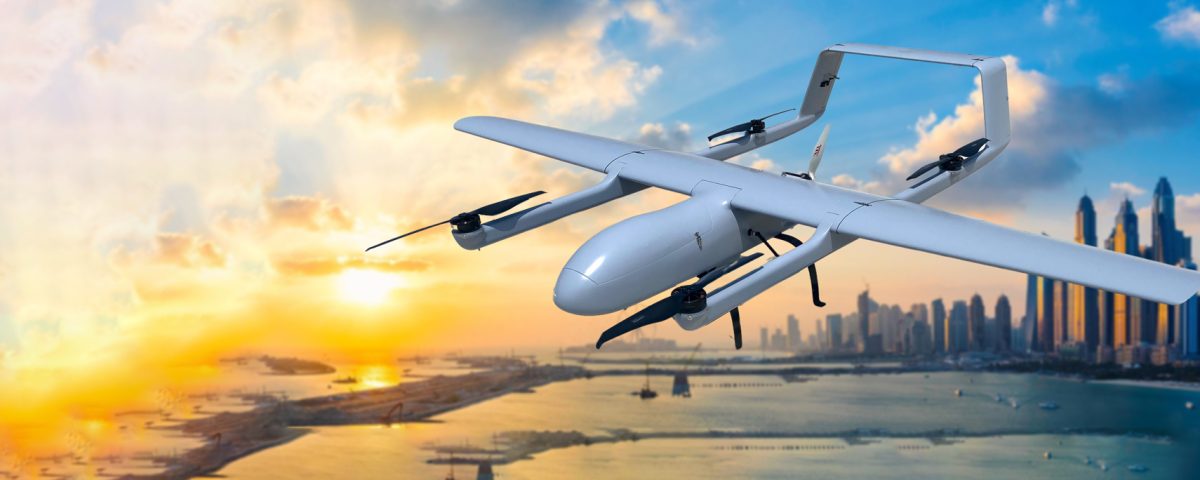Vertical Take-Off and Landing (VTOL) fixed-wing UAVs have rapidly become the backbone of the industrial drone sector. By combining the agility of multirotors with the endurance and efficiency of fixed-wing aircraft, VTOL UAVs offer a hybrid capability—vertical take-off plus long-endurance cruising—that opens entirely new possibilities across industries. Companies like AIRMOBI, with its Skyeye series and V-series VTOL platforms, are leading this transformation by delivering UAV solutions designed for professional missions in power inspection, logistics, emergency response, and beyond.
Core Technological Advantages and Application Logic
The strength of VTOL UAVs lies in their composite propulsion systems—whether multirotor + fixed-wing or tilt-rotor—allowing them to balance flexible deployment with efficient long-range flight.
-
Runway-Free Operations: Able to take off and land in confined or rugged terrains such as mountains, forests, or rooftops, VTOL UAVs excel in emergency missions and remote area operations. The AIRMOBI V35 VTOL platform, for example, can be rapidly deployed without infrastructure, ensuring flexibility in complex environments.
-
Long Endurance and Range: Hybrid gasoline-electric models can achieve flight times of up to 12 hours with operational radii exceeding 200 km. The Skyeye 5000 Octo VTOL, with its endurance surpassing 8 hours and payload capacity of 25 kg, is well suited for long-range transport and large-area inspections.
-
High Payload Versatility: From 0.8 kg to 25 kg, VTOL UAVs can carry payloads such as LiDAR, thermal cameras, fire suppression bombs, or multispectral sensors. AIRMOBI platforms are designed with modular payload bays, allowing quick swaps between surveying equipment, EO/IR gimbals, or logistics pods.
-
Automation and Swarm Collaboration: Full autopilot integration enables autonomous flight, multi-drone cluster operations, and real-time data transmission, greatly improving operational efficiency. Paired with long-range video/data transmission systems, AIRMOBI UAVs ensure stable, secure connectivity for mission-critical applications.
Key Application Scenarios
1. Emergency Response and Disaster Relief
VTOL UAVs are invaluable in crisis scenarios such as earthquakes, floods, or forest fires. They provide rapid aerial intelligence through photogrammetry, LiDAR mapping, and 3D terrain modeling. For example, in simulated disaster drills, dual-UAV deployments completed 20 km² of mapping in just two hours, delivering actionable intelligence to command centers.
-
Equipped with parachute payload systems, UAVs can deliver medical supplies and communications kits into isolated zones.
-
Mounted with thermal cameras, platforms like the AIRMOBI V39 can locate missing persons through smoke or darkness, supporting first responders.
2. Energy and Infrastructure Inspection
Power grids, pipelines, and telecom infrastructure benefit greatly from UAV-enabled inspections.
-
Automated “drone-in-a-box” systems enable routine patrols across hundreds of kilometers of power lines. AI algorithms automatically flag anomalies such as insulator damage or abnormal tower heating.
-
In petrochemical or mining facilities, UAVs fitted with gas sensors provide real-time monitoring of hazardous emissions, improving both safety and compliance.
3. Mapping and Geospatial Intelligence
With RTK/PPK GNSS, VTOL UAVs achieve centimeter-level accuracy for surveying.
-
Platforms such as the Skyeye 3600 VTOL UAV can cover 30 km² per sortie at 1:500 mapping scale, significantly reducing field labor.
-
In urban planning, digital twin models generated from UAV imagery support traffic analysis, construction monitoring, and smart city development.
4. Logistics and Cargo Delivery
Logistics is one of the most promising commercial frontiers for VTOL UAVs.
-
Demonstrations in China have proven UAV transport over 80 km maritime routes, reducing delivery time from hours to under an hour.
-
On mountain routes, UAVs bridge the “last mile” by bypassing blocked or non-existent roads. With payload capacities of up to 10–45 kg, AIRMOBI VTOL platforms offer cost-effective solutions for both commercial freight and emergency supply delivery.
5. Security and Public Safety
Border patrol, maritime surveillance, and urban policing are increasingly adopting UAV solutions.
-
With EO/IR payloads and AI-enabled recognition, drones can monitor coastal zones, identify suspicious vessels, or detect unauthorized border crossings.
-
In cities, UAVs enhance public safety by patrolling blind spots, monitoring traffic congestion, or supporting crowd management during large events.
6. Agriculture and Environmental Protection
-
Equipped with multispectral sensors, UAVs can analyze crop health, optimize irrigation, and guide precision spraying.
-
For environmental protection, UAVs track wildlife migration, monitor deforestation, and support anti-poaching operations. With payload flexibility, AIRMOBI’s VTOL UAVs can switch seamlessly between agricultural and ecological monitoring missions.
7. Low-Altitude Economy and Emerging Scenarios
-
In urban air mobility (UAM), passenger-grade VTOL UAVs are under testing and may alleviate road congestion in the future.
-
Integrated with 5G and AI, UAVs enable beyond-visual-line-of-sight (BVLOS) operations and predictive maintenance of telecom infrastructure.
Industry Practices and Success Cases
-
Power Grid Inspection at Scale: In Yunnan, a fleet of VTOL UAVs now covers 250+ km² of grid infrastructure, replacing traditional ground patrols and saving over 80% in manpower.
-
Commercial Logistics Breakthrough: Pilot UAV routes in mountainous regions have cut delivery costs by 40%, proving the viability of large-scale deployment.
-
Emergency Mapping Innovation: Dual-UAV collaborations in plateau environments enable “data collection–modeling–analysis” loops in real time, greatly improving disaster response speed.
Future Outlook
-
Technological Evolution: Fuel-cell propulsion, advanced swarm algorithms, and lightweight composites will further enhance UAV endurance and payloads.
-
Policy and Regulation: With low-altitude economy strategies being rolled out globally, issues such as airspace integration, certification, and data security remain critical for large-scale adoption.
-
Industry Convergence: VTOL UAVs will increasingly integrate with IoT, digital twins, and AI systems, driving new applications such as “UAV + Smart City” and “UAV + Smart Agriculture.”
Conclusion
VTOL fixed-wing UAVs are redefining the boundaries of unmanned aviation. By lowering operational costs while expanding mission complexity, they empower industries to embrace automation and intelligence. From disaster relief to logistics, from infrastructure inspection to ecological monitoring, these platforms are becoming the essential infrastructure of the low-altitude economy.
With its extensive portfolio—including the AIRMOBI Skyeye series, V-series VTOLs, and Swiftlink transmission systems—AIRMOBI is committed to being a global leader in industrial UAV solutions, driving innovation and enabling businesses and governments to operate smarter, safer, and more efficiently in the skies.


